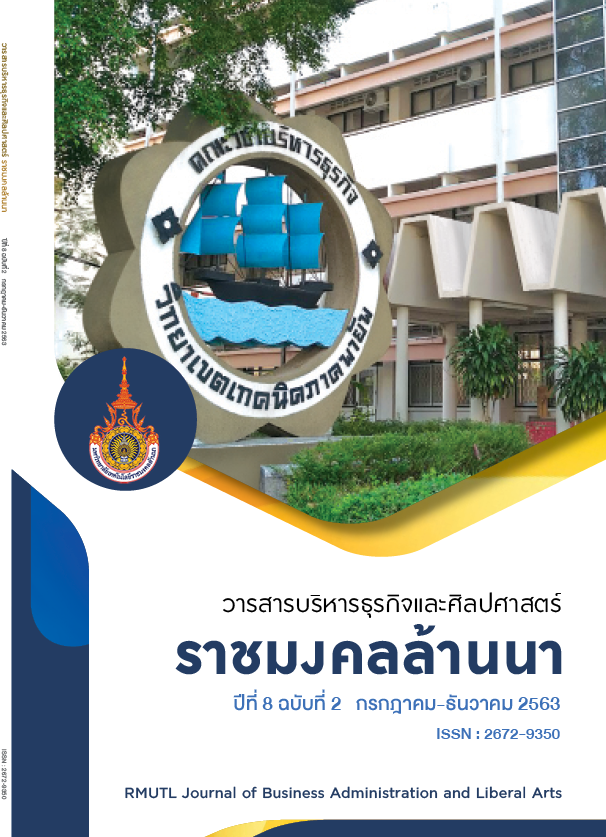The Participation of Citizen in the community of Wat Nong Kham, Chang Moi Subdistrict, Mueang District, Chiang Mai Province, Towards Preventing and Solving Tobacco Control Products Act 2017 Problems
Main Article Content
Abstract
This article aims of research (1) to study the level of participation of people in the community at Wat Nong Kham, Chang Moi Sub-district, Muang District, Chiang Mai Province, in preventing and solving problems according to the act tobacco products control 2017 (2) to compare the level of participation of people in the community at Wat Nong Kham, in preventing and solving problems according to the act tobacco products control 2017 was classified by gender, age, education level and occupation and (3) to suggest participation of people in the community at Wat Nong Kham, in preventing and solving problems according to the act tobacco products control 2017 is a quantitative research. Using survey research methods apply the theoretical concepts related to participation, concepts of smoking behavior and factors affecting smoking; and in the issue of prevention and problem solving according to the act tobacco products control 2017 as a framework for research studies.
The population used in this study was: People living or having residence in the area of Wat Nong Kham Community Area, the researcher used the Non probability random sampling, Snowball sampling, using 200 samples and wanted to research behavior. Stakeholders in participation residing or having residence in the area of Wat Nong Kham community area, the tool used in this research was a questionnaire. One-way ANOVA was used to analyze the F-test when statistically significant.
The research found that males (124 people) more than females (76 people), 62.0 percent and 38.0 percent, age 31-40 years (77 people), marital status, single (90 people), have a primary education level, study (148 people) on participation in problem / cause discovery and planning activities, overall, it was at a low level ((x̄) = 1.5275, (S.D.) = 0.49782). It was found that participation in holding a consultation meeting for the implementation of problem prevention in accordance with the civil service act. To control tobacco products 2017 of Wat Nong Kham community high mean ((x̄) = 1.6000, (S.D.) = 0.49113) participation in investment and work, overall, it was at the lowest level ((x̄) = 1.2400, (S.D.) = 0.42506). Information about the dangers and dangers of cigarettes, such as organizing boards, flyers, posters, stickers, no smoking, etc., to the community sources. high mean ((x̄) = 1.1950, (S.D.) = 0.39719) follow-up participation, overall, it was at the lowest level ((x̄) = 1.2791, (S.D.) = 0.44907). It was found that the participation in the evaluation of the problem prevention performance in accordance with the national crime act, to control tobacco products 2017 of Wat Nong Kham community Have a high mean ((x̄) = 1.3100, (S.D.) = 0.46365).
Gender, age, marital status, education level and occupation of citizens located in the area of Wat Nong Kham community, participation of the people to prevent and solve problems in accordance with the act, the 2017 tobacco product control of Wat Nong Kham community was not significantly different at the 0.05 level of participation in problem-finding / cause and planning activities. In terms of participation in investment and performance and in the field of participation in monitoring results, there was no statistically significant difference at the 0.05 level and in the overall three areas there was no statistically significant difference at the 0.05 level.
Public participation It should be in accordance with the upstream, midstream and downstream guidelines to make the project or activity carried out, it will have a significant impact on stakeholders in all sectors. In preparing a prevention development plan and solve problems according to the act control of tobacco products 2017 of Wat Nong Kham Community, lack of implementation in all four steps: (1) co-think (2) co-plan (3) co-operation and (4) co-evaluate, as a result, prevent development plans were not created, and fix problems, which may consist of various activities or projects in the whole because of the lack of a 4 step process, important conditions are (1) community leaders or community leaders (2) the process of driving activities or development projects within the community (3) sharing of knowledge from experiences of other communities. And external agencies and (4) attitude of the community within the community towards the participation process in the preparation of the prevention development plan and solve problems according to the act tobacco products control 2017 of Wat Nong Kham community does not happen continuously.
Article Details
บทความวิจัยนี้เป็นของลิขสิทธิ์
References
พวงรัตน์ บุญญานุรักษ์. (2544). การเรียนรู้โดยใช้ปัญหา PROBLEM-BASED LEARNING(วิทยานิพนธ์ศิลปศาสตร์มหาบัณฑิต). ชลบุรี: มหาวิทยาลัยบูรพา.
ทิศนา แขมมณี. (2545). ศาสตร์การสอน. กรุงเทพมหานคร: สํานักพิมพ์แห่งจุฬาลงกรณ์มหาวิทยาลัย.
มหาเถรสมาคม. (2562). พระราชบัญญัติควบคุมผลิตภัณฑ์ยาสูบ พ.ศ. 2560. กรุงเทพมหานคร: สำนักงานพระพุทธศาสนาแห่งชาติ.
มัณฑรา ธรรมบุศย์. (2545). การพัฒนาคุณภาพการเรียนรู้ โดยใช้ PBL (Problem-Based Learning). กรุงเทพมหานคร: กรมวิชาการ. 2. 11-17.
เริงฤดี ปธานวนิช และสุทัศน์ รุ่งเรืองหิรัญญา. (2562). เราสูญเสียไปเท่าไหร่? จากการสูบบุหรี่. กรุงเทพมหานคร: คณะแพทยศาสตร์ โรงพยาบาลรามาธิบดี.
วัฒนา รัตนพรม. (2548). การวิจัยในชั้นเรียน. กรุงเทพมหานคร: สุวีริยาสาส์น.
สนิท ดีเมืองซ้าย. (2552). การเรียนรู้โดยใช้ปัญหาเป็นหลักรูปแบบการเรียนรู้โดยผู้เรียนเป็นศูนย์กลาง. พิมพ์ครั้งที่ 2. กรุงเทพมหานคร: บุ๊คเลท.
สุนทรี คนเที่ยง. (2544). หลักกระบวนการแก้ปัญหา. พิมพ์ครั้งที่ 4. กรุงเทพมหานคร: สถาบันบัณฑิตพัฒนบริหารศาสตร์.
Barrows, H. S., & Tamblyn, R. M. (1980). Problem-Based Learning: An Approach to Medical Education. New York: Springer.
Bundhamcharoen, K., Aungkulanon, S., Makka, N., & Shibuya, K. (2015). Economic burden from smoking-related diseases in Thailand. Tobacco control, tobaccocontrol-2015.
Barell , John. (1998). PBL an Inquiry Approach. Illinois: Skylight Training and Publishing.
Barbara J.Duch. (1995). Teaching Archaeology in the Twenty-First Century. Washington, D.C.: Society for American Archaeology.
Colman, M.R. (1995). Problem-Based Learning: A New Approach for teaching Gifted Students. Gifted Today Magazine, 18, 18-19.
Edens,. (2000). Learning Package Versus Conventional Method of Instruction. Dissertation Abstracts International, 32(8), 4295-A.
Gallagher, B. (2001). The role of food and beverage in tourism. In Tourism as a catalyst for community development conference. Pretoria, South Africa: n.p
Linda Torp & Sara Sage. (1998). Problems as Possibilities: Problem-based Learning for K-12 Education. ASCD, North Beauregard Street, Alexandria, VA.
United Nations. (1981). Yearbook of International Trade Statistics. United Nations: UN Press.
White,. (1996). The Perceptions of Four Participant Groups of the Effects of Administrative Transfers on Utah Centenial School Programs. Dissertation Abstract International, 38(2), 399-401.

